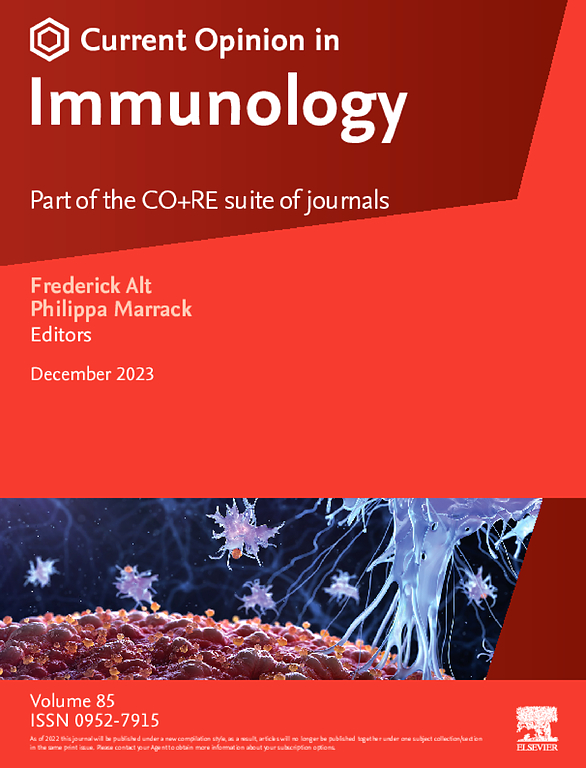Mechanistic considerations linking SARS-CoV-2 infection, inflammation, and the loss of immune tolerance
IF 5.8
2区 医学
Q1 IMMUNOLOGY
引用次数: 0
Abstract
The immune response to SARS-CoV-2 has been implicated in the onset of multiple, seemingly unrelated, autoimmune diseases. The immune response to SARS-CoV-2 has also been implicated in the unmasking and/or production of multiple autoantibodies, even in the absence of clinical disease. Despite such data, it remains unclear whether antibodies targeting antiviral signaling proteins and mitochondrial antigens reflect bystander activation or alternatively contribute to de novo viral immune escape mechanisms. With these comments in mind, a variety of professional antibody presenting cells and including lung resident macrophages of COVID-19 infected patients are impacted and dependent on the uptake of antibody-opsonized virus by Fcγ receptors; yet infection is aborted via antibody-dependent effector mechanisms or pyroptosis, possibly leading to autoantibody production, and autoinflammatory manifestations, respectively.
TRIM21/Ro52, a cytosolic E3-ubiquitin ligase with an Fc-gamma receptor domain, functions as an intracytoplasmic antibody receptor, directs immune complexes binding virions but also autoantigens to autophagy. During autophagy, Ig-virions-TRIM21/Ro52-autoantigens complexes bind directly to class II human leukocyte antigen in lysosomal compartment, leading to subsequent presentation on the cell surface. This process favors the development of a specific humoral immune response but has the potential to lead to loss of tolerance. Interestingly, TRIM21/Ro52 can also contribute to pyroptosis. We propose that TRIM21/Ro52 is well-placed at the crossroad between the inflammatory response and clinical autoimmunity.
将SARS-CoV-2感染、炎症和免疫耐受丧失联系起来的机制考虑
对SARS-CoV-2的免疫反应与多种看似无关的自身免疫性疾病的发病有关。即使在没有临床疾病的情况下,对SARS-CoV-2的免疫反应也与多种自身抗体的揭露和/或产生有关。尽管有这样的数据,但仍不清楚靶向抗病毒信号蛋白和线粒体抗原的抗体是否反映了旁观者的激活或是否有助于从头开始的病毒免疫逃逸机制。考虑到这些观点,各种专业抗体提呈细胞,包括COVID-19感染患者的肺常驻巨噬细胞受到影响,并依赖于Fcγ受体对抗体活化病毒的摄取;然而,感染通过抗体依赖效应机制或焦亡而终止,可能分别导致自身抗体产生和自身炎症表现。TRIM21/Ro52是一种具有fc - γ受体结构域的胞质e3泛素连接酶,作为胞浆内抗体受体,指导免疫复合物结合病毒粒子和自身抗原进行自噬。在自噬过程中,igg -病毒粒子- trim21 / ro52 -自身抗原复合物在溶酶体腔室中直接与II类人白细胞抗原结合,导致随后在细胞表面呈现。这个过程有利于特定体液免疫反应的发展,但有可能导致耐受性丧失。有趣的是,TRIM21/Ro52也可以促进焦亡。我们认为TRIM21/Ro52处于炎症反应和临床自身免疫之间的十字路口。
本文章由计算机程序翻译,如有差异,请以英文原文为准。
求助全文
约1分钟内获得全文
求助全文
来源期刊
CiteScore
13.30
自引率
1.40%
发文量
94
审稿时长
67 days
期刊介绍:
Current Opinion in Immunology aims to stimulate scientifically grounded, interdisciplinary, multi-scale debate and exchange of ideas. It contains polished, concise and timely reviews and opinions, with particular emphasis on those articles published in the past two years. In addition to describing recent trends, the authors are encouraged to give their subjective opinion of the topics discussed.
In Current Opinion in Immunology we help the reader by providing in a systematic manner: 1. The views of experts on current advances in their field in a clear and readable form. 2. Evaluations of the most interesting papers, annotated by experts, from the great wealth of original publications.
Current Opinion in Immunology will serve as an invaluable source of information for researchers, lecturers, teachers, professionals, policy makers and students.
Current Opinion in Immunology builds on Elsevier''s reputation for excellence in scientific publishing and long-standing commitment to communicating reproducible biomedical research targeted at improving human health. It is a companion to the new Gold Open Access journal Current Research in Immunology and is part of the Current Opinion and Research(CO+RE) suite of journals. All CO+RE journals leverage the Current Opinion legacy-of editorial excellence, high-impact, and global reach-to ensure they are a widely read resource that is integral to scientists'' workflow.

 求助内容:
求助内容: 应助结果提醒方式:
应助结果提醒方式:


